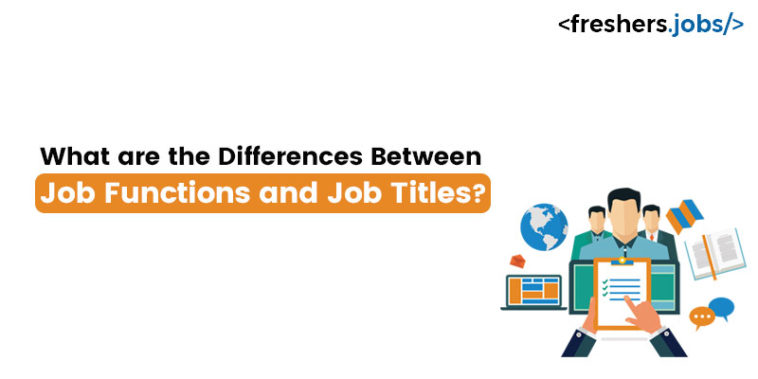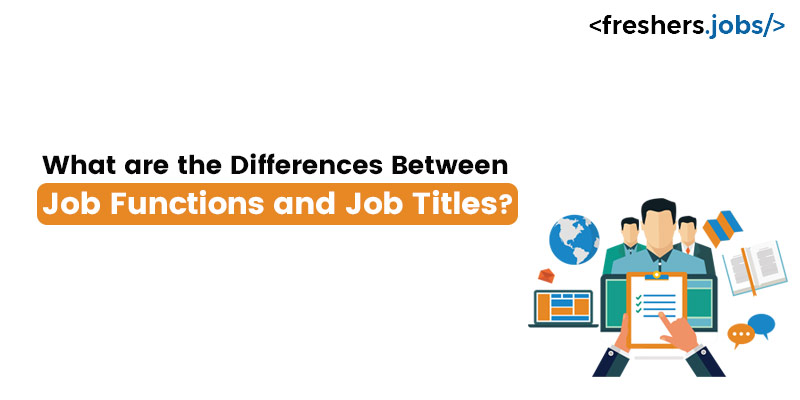In employment, “job position” and “job title” are often used interchangeably, confusing their precise meanings and distinctions. While both terminologies are related to employment roles, they have different characteristics and serve different purposes within organisational contexts. Understanding the differences between job positions and job titles is important for employers and employees as it clarifies roles, responsibilities, and hierarchical structures.
This blog sheds light on the disparities between job positions and freshers jobs titles, what is a job title and what a job position providing insights into how these terms contribute to the organisation’s overall structure, recruitment processes, and employee management. By grasping these, individuals and organisations can enhance their comprehension of job roles and effectively navigate the complexities of the modern workplace.
Let us Know What is a Job position?
A job position is a specific role or position within an organisation associated with responsibilities, tasks, and qualifications. It represents a distinct functional area or expertise within the organisational structure. A job position is typically defined based on the skills, knowledge, and experience required to effectively perform the duties associated with that role.
A job position or job opportunity encompasses various aspects, such as the specific job tasks, the reporting structure, authority and responsibility, and the required qualifications or credentials. It also shows the essential functions and requirements of the role, providing a clear understanding of the position’s purpose within the organisation.
Position in job are typically created based on the needs of the organisation and the division of labour required to achieve its goals. They can range from entry-level to managerial or executive roles, each with unique responsibilities and requirements.
Job positions serve as a basis for recruitment and selection processes and for evaluating employee performance, career development, and freshers salary compensation decisions. They provide a framework for defining the scope of work, establishing accountability, and aligning individual roles with the organisation’s overall objectives.
In the below sections, we shall see the job title vs designation differences.
Why are job functions essential?
Job functions are essential for several reasons:
Clarity and Alignment: Clearly defined job functions provide the employees with a clear understanding of their roles and responsibilities. By knowing what is expected of them, employees can align their efforts towards fulfilling their tasks and contribute to the organisation’s overall goals. Job functions ensure everyone understands their specific contributions and how their work fits the bigger picture.
Efficient Workflow: When job functions are well-defined, it promotes efficiency in the workplace. Employees can prioritise their tasks, manage their time effectively, and collaborate with others more seamlessly. Clarity on job functions helps streamline processes and minimises confusion or overlaps in responsibilities, ensuring a smoother workflow and increased productivity.
Performance Evaluation: Job functions serve as a basis for evaluating employee performance. When job functions are clearly defined, it becomes easier to assess how well employees are fulfilling their responsibilities and meeting the expected outcomes. Performance evaluations can be more objective and fair based on specific job functions and criteria.
Training and Development: Job functions provide a framework for identifying skill gaps and determining training and development needs. By understanding the difference between job title and designation of the required tasks and responsibilities, organisations can design training programs that address specific job functions, helping employees enhance their skills and knowledge in critical areas.
Career Progression: Job functions play a crucial role in career progression. As employees gain experience and expertise in their current job functions, they can aspire to take on higher-level roles or expand their responsibilities within their current positions. Precise job functions provide a roadmap for career growth and career advancement opportunities within the organisation. Henceforth know the difference between job and position to have a career progression.
What is a job title?
A job title is a formal designation or name given to a specific position or role within an organisation. It represents the title or label used to identify and distinguish a job within the organisation’s hierarchy or structure. Job titles often reflect the level of responsibility, seniority, and area of expertise associated with the position.
Job titles can vary widely across different industries and organisations. They can range from generic titles like “Manager” or “Supervisor” to more specific titles like “Software Engineer,” “Marketing Specialist,” or “Financial Analyst.” Job titles may also include additional descriptors such as “Senior,” “Junior,” “Associate,” or “Executive” to indicate varying levels of experience or seniority within a particular role.
Job titles serve several purposes within the organisation. They provide a standardised way of referring to specific positions internally and externally, allowing for clear communication and understanding of the roles and responsibilities associated with each title. Job titles also help establish a hierarchy and structure within the organisation, indicating reporting relationships and levels of authority.
Additionally, job titles can influence perceptions of status and career progression. They often contribute to an individual’s professional identity and can be used as a benchmark for comparing salaries, responsibilities, and career advancement opportunities across similar roles within the industry.
What is a job title? While job titles provide a quick way to identify and categorise positions, it’s important to note that they may not always capture the full scope of job functions or responsibilities associated with a particular role. Therefore, referring to detailed job descriptions or discussing job functions alongside job titles is essential to understand a specific position comprehensively.
For more jobs at IT stream as Software Engineers, Tap to find the latest openings from freshers jobs in Chennai.
Why are job titles important?
Communication and Clarity: Job titles provide a standardised and concise way to communicate and refer to specific organisational positions. They help establish a common language and understanding of roles and responsibilities internally and externally. Job titles make it easier to convey someone’s position within the organisation and facilitate effective communication across teams, departments, and external stakeholders.
Role Definition and Expectations: Job titles significantly define and set expectations for a particular position. They give a general idea of the scope of work, responsibilities, and level of authority associated with a role. Job titles help individuals understand their role within the organisation and the contributions they are expected to make. They also help employers and managers assign tasks, delegate responsibilities, and manage workloads more efficiently.
Career Progression and Professional Identity: Job titles often signify seniority, expertise, and experience within a particular field or industry. They can provide a sense of career progression, position in job and advancement opportunities within an organisation. Job titles also contribute to an individual’s professional identity and can impact how they are perceived within and in the job market. They can influence salary negotiations, job satisfaction, and career prospects.
External Perceptions and Marketability: Job titles can impact how the company is perceived by external stakeholders such as clients, partners, or investors. A well-defined and recognisable job title can convey a sense of professionalism, expertise, and credibility. Additionally, job titles can influence an individual’s marketability and career prospects outside their current organisation, as they often serve as a reference point for employers and recruiters when assessing qualifications and experience.
Organisational Structure and Hierarchy: Job titles contribute to establishing a clear organisational structure and hierarchy within an organisation. They help define reporting relationships and levels of authority, allowing for effective decision-making and workflow management. Job titles enable employees to understand their position within the organisation’s structure and facilitate career growth and advancement opportunities.
What is the difference between job positions and job roles?
Here is the difference in job title vs designation, job positions and roles are commonly used to describe the responsibilities and functions of a specific position within an organisation. While these terms are related, they have distinct characteristics that are important to understand. Individuals and organisations can understand these concepts and their significance in the workplace by delving into the differences between job positions and roles.
Defining Job Positions
A job position is a specific role or position within an organisation associated with responsibilities, tasks, and qualifications. It represents a distinct functional area or expertise within the organisational structure. Job positions are typically created based on the needs of the organisation and the division of labour required to achieve its goals.
Job positions encompass various aspects such as specific job tasks, reporting structure, level of authority and responsibility, and required qualifications or credentials. They outline the essential functions and requirements of the role, providing a clear understanding of the position’s purpose within the organisation.
Meaning of job position is often designated by formal titles such as “Project Manager,” “Accountant,” or “Sales Representative.” These titles serve as labels that identify and distinguish the position within the organisation’s hierarchy or structure. Job positions are crucial in recruitment processes, performance evaluations, career development, and compensation decisions.
Understanding Job Roles
On the other hand, job roles refer to the specific responsibilities, tasks, and functions that an individual is expected to fulfil within their job position. Job roles delve deeper into a particular position’s day-to-day activities and duties.
While job positions provide a broad overview of the role and its purpose, job roles provide a more detailed description of the specific tasks and responsibilities an individual is responsible for. Job roles are typically outlined in job descriptions, outlining the expectations and deliverables of a particular position.
For example, a “Marketing Manager” position may have various roles, such as creating marketing strategies, managing advertising campaigns, conducting market research, analysing marketing data, and overseeing a team of marketing professionals. These job roles clarify the activities and function the Marketing Manager is responsible for.
Distinguishing the Differences
The key difference between job title vs designation lies in their level of specificity. Job positions provide a broader overview and designation of a particular role within the organisational structure. In contrast, job roles offer a more detailed breakdown of the responsibilities and tasks associated with that role.
Job positions focus on the title and general purpose of the position within the organisation. They highlight the level of authority, reporting relationships, and qualifications required for the role. Job positions provide a framework for understanding the organisation’s structure and how individual roles fit.
On the other hand, job roles concentrate on the specific functions and responsibilities that individuals are expected to perform within their positions. They outline a particular role’s day-to-day tasks, deliverables, and expectations. Job roles provide individuals with a clear understanding of their responsibilities, helping them prioritise their work and contribute effectively to the organisation.
It’s important to note that positions in job and job roles are interconnected. Job positions define a role’s broader context and purpose, while job roles provide a detailed breakdown of tasks and responsibilities within that position.
Benefits of Understanding Job Positions and Job Roles
Understanding the differences between job positions and roles benefits individuals and organisations.
For individuals, clarity on job positions and job roles helps in the following:
Self-Assessment: Understanding job positions and roles allows individuals to assess their skills, qualifications, and interests in specific positions. It helps them identify suitable career paths and make informed decisions about their professional development.
Performance Management: Clear knowledge of job positions and roles enables individuals to effectively align their efforts and focus on fulfilling their responsibilities. It facilitates better performance management, as individuals can evaluate their performance based on the specific expectations associated with their roles and thus know the difference between job and position.
Career Growth: By understanding the relationship between job positions and roles, individuals can identify areas for growth and advancement within their current positions. They can acquire the necessary essential skills and experience to take on additional responsibilities and progress in their careers.
For organisations, understanding job positions and job roles contributes to the following:
Recruitment and Selection: Clear job positions and well-defined job roles aid in attracting and selecting suitable candidates for specific positions. Job descriptions that outline job roles provide candidates with a clear understanding of the responsibilities and requirements of the role, allowing for better alignment between candidate qualifications and organisational needs.
Workforce Planning: Understanding job positions and roles assists organisations in strategic workforce planning. By analysing each position’s specific functions and responsibilities, organisations can assess their workforce needs, identify skill gaps, and make informed decisions about hiring training and development initiatives.
Workflow Efficiency: Well-defined job roles explain what is a job title and promote efficient workflow management within the organisation. Employees can clearly understand their responsibilities, prioritise tasks, and collaborate effectively with colleagues. Clear job roles minimise duplication of efforts, confusion, and conflicts regarding responsibilities.
Freshers can choose the best IT company for software engineering jobs, Tap to HP jobs for freshers.
Performance Evaluation: Job positions and roles provide a basis for evaluating employee performance. By having clearly defined expectations and responsibilities, organisations can assess how well employees fulfil their roles and meet performance objectives. Performance evaluations can be more objective and meaningful based on specific job roles and criteria.




